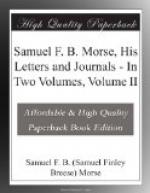On April 8 (Holy Thursday), Morse went early with Mr. Fenimore Cooper and other Americans to St. Peter’s. After describing some of the preliminary ceremonies he continues:—
“Having examined the splendid chair in which he was to be borne, and while he was robing in another apartment, we found that, although we might have a complete view of the Pope and the ceremonies before and after the benediction, yet the principal effect was to be seen below. We therefore left our place at the balcony, where we could see nothing but the crowd, and hastened below. On passing into the hall we were so fortunate as to be just in season for the procession from the Sistine Chapel to the Pauline. The cardinals walked in procession, two and two, and one bore the host, while eight bearers held over him a rich canopy of silver tissue embroidered with gold.
“Thence we hastened to the front of St. Peter’s, where, in the centre upon the highest step, we had an excellent view of the balcony, and, turning round, could see the immense crowd which had assembled in the piazza and the splendid square of troops which were drawn up before the steps of the church. Here I had scarcely time to make a hasty sketch, in the broiling sun, of the window and its decorations, before the precursors of the Pope, the two large feather fans, made their appearance on each side of the balcony, which was decorated with crimson and gold, and immediately after the Pope, with his mitre of gold tissue and his splendid robes of gold and jewels, was borne forward, relieving finely from the deep crimson darkness behind him. He made the usual sign of blessing, with his two fingers raised. A book was then held before him in which he read, with much motion of his head, for a minute. He then rose, extending both his arms—this was the benediction—while at the same moment the soldiers and crowd all knelt; the cannon from the Castle of St. Angelo was discharged, and the bells in all the churches rang a simultaneous peal.
“The effect was exceedingly grand, the most imposing of all the ceremonies I have witnessed. The Pope was then borne back again. Two papers were thrown from the balcony for which there was a great scramble among the crowd.”
On Friday, April 9 (Good Friday), many of the ceremonies so familiar to visitors to Rome during Holy Week are described at length in the notebooks, but I shall omit most of these. The following note, however, seems worthy of being recorded:—
“On our way to St. Peter’s I ought to have noticed our visit to a palace in which another cardinal (the third who has died within a few days) was lying in state—Cardinal Bertazzoli.
“It is a singular fact, of which I was informed, that about the same time last year three cardinals died, and that it was a common remark that when one died two more soon followed, and the Pope always created three cardinals at a time.”




